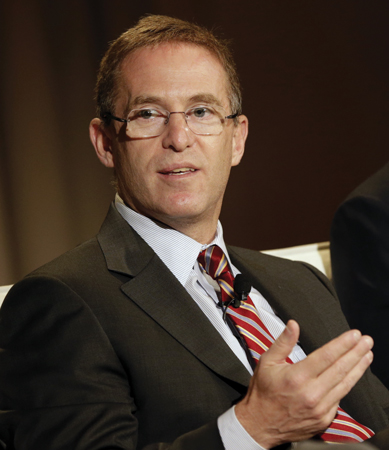Trade publications are littered with stories about the promise of virtual reality, mostly filled with quotes from people with a stake in the game. They are pushing virtual reality just as forcefully as they pushed 3-D television a few years ago.
But my ears perked up when SportsNet New York President Steve Raab evangelized on the technology during an interview last week. We were talking on the occasion of SNY’s 10th anniversary — it launched March 16, 2006 — and I asked a standard question about how SNY will look in 2026. That was when Raab started talking about virtual reality, a technology that he described as jaw-dropping.
 |
"[Virtual reality] hasn't really reached up today. But, boy, when you see it, it's pretty breathtaking."
STEVE RAAB
PRESIDENT, SPORTSNET NEW YORK
Photo by: GETTY IMAGES |
“I’m really bullish on virtual reality,” he said. “Ten years from now, that’s going to have made real inroads. … It hasn’t really reached us today. But, boy, when you see it, it’s pretty breathtaking.”
Raab is not an executive known for hyperbole. Having spent his career in the sports business — he was a 24-year-old general manager of the CBA’s Sioux Falls Skyforce in 1989 — Raab has earned a reputation as a measured, forward-thinking executive.
While he sees virtual reality as being a potential boon for networks like SNY, he also thinks that it could become a big disrupter for pro sports teams.
Today’s VR experience is good. Eventually, the VR experience could get so good that it could keep people from attending games.
“Remember when Ted Turner’s original
WCW used to be wrestling in a studio on the Turner campus with 400 seats around the ring,” Raab said. “That’s what I’m starting to feel like we might see one day in professional sports. The venues will really be quite small because virtual reality will give you such a terrific experience. You’re not going to be able to get 20,000 people to a basketball game, so you’re going to build a 4,000-person arena. Then you’re going to have another 200,000 watching it from home on VR.”
That’s certainly more than 10 years away. But Raab said that fans are consuming sports today in ways that were not even considered 10 years ago. Ten years from now, consumers will be using some sort of technology that does not exist today.
In fact, when Raab described the media business from 2006, he made it sound quaint. High definition was still growing and flip phones were all the rage. iPhones didn’t launch for another year.
“Ten years ago, when we were negotiating the first distribution deals, you know what the big point of discussion was outside of price? HD,” Raab said. “That’s remarkable. We didn’t even carry all the Mets games in HD that first year. That was not the norm at the beginning.”
Raab was SNY’s top marketing executive when SNY launched in 2006. He was promoted to president a year later when Jon Litner left to take a bigger job at Comcast.
At the time of the launch, SNY set a strategy of staying close to cable operators as a way of making sure they could get carriage. Majority owned by the New York Mets, SNY also allowed New York’s two dominant cable operators to take ownership stakes — Time Warner Cable holds 27 percent of the RSN and Comcast owns 8 percent.
While pay-TV distribution still is the biggest issue facing TV sports channels today, all are looking at different platforms and exploring options of selling their service directly to the consumer.
The hottest issues for RSNs today — in-market streaming and over-the-top delivery — seemed the stuff of science fiction 10 years ago.
“These are all a byproduct of advancement in technology over 10 years,” Raab said. “2006 just seems archaic now. The whole digital media for RSNs — RSNs saw themselves solely as TV networks. Back then, a lot of RSNs had websites because it felt like you had to have a URL and you needed to have something on a home page. But nobody was looking to invest or even staff in those areas at that time. Now, we’re talking about being platform agnostic and maximizing the different platforms.”
John Ourand can be reached at jourand@sportsbusinessjournal.com. Follow him on Twitter @Ourand_SBJ.





